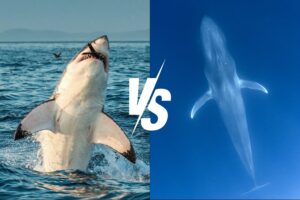
The blue whale and the lion are two of nature’s most iconic animals, but they inhabit vastly different environments and possess unique adaptations that make them formidable in their respective domains. This article explores the physical characteristics, behaviors, and ecological roles of both species to determine who would prevail in a hypothetical confrontation.
Physical Characteristics between Blue Whale vs. Lion
Size Comparison
One of the most significant differences between the blue whale and the lion is their size. The blue whale is the largest animal known to have ever existed, reaching lengths of up to 100 feet and weighing as much as 200 tons. In contrast, lions are much smaller; male lions typically weigh between 330 to 550 pounds and measure about 8 to 10 feet in length, including their tails.
| Characteristic | Blue Whale | Lion |
|---|---|---|
| Length | Up to 100 feet | 8 to 10 feet |
| Weight | Up to 200 tons | 330 to 550 pounds |
| Habitat | Ocean | Grasslands, savannas |
Strength and Power
The blue whale’s massive size translates into immense strength. Its powerful tail flukes allow it to swim efficiently through the water, reaching speeds of up to 20 miles per hour. This power is unmatched by terrestrial animals like lions, whose maximum speeds are around 30-50 miles per hour in short bursts. However, this speed is only effective on land; in water, lions would be at a severe disadvantage.
Habitat Differences
Terrestrial vs. Aquatic Environments
Lions primarily inhabit grasslands and savannas in Africa, while blue whales thrive in oceanic environments. The vastness of the ocean provides blue whales with ample space to maneuver, making them incredibly agile despite their size. Lions are adapted for life on land, relying on their strength and teamwork when hunting.
Behavioral Aspects
Hunting Techniques
Lions are social animals that hunt in groups known as prides. This social structure allows them to take down larger prey through coordinated efforts. Female lions do most of the hunting, using strategies that involve stalking and ambushing.In contrast, blue whales feed primarily on small marine organisms like krill using a technique called filter feeding. They take in large volumes of water rich in krill through their mouths and then expel the water through their baleen plates, trapping the food inside. This feeding strategy highlights the blue whale’s unique adaptations for survival in its aquatic environment.
Aggression Levels
While lions are known for their territorial behavior and can exhibit aggression when defending their pride or territory, blue whales are generally peaceful creatures that do not exhibit aggressive behavior towards other species. Their primary focus is on feeding and migration.
Historical Context
Animal Encounters
Historically, there have been no recorded encounters between blue whales and terrestrial predators like lions due to their vastly different habitats. In controlled environments such as zoos or aquariums, interactions between these species are impossible because blue whales cannot survive outside their aquatic habitat.In contrast, encounters between lions and other large predators have been documented. Lions often engage in aggressive interactions with rival males when defending their territory. However, these encounters do not provide any relevant insight into how a lion would fare against a blue whale.
Conclusion
In conclusion, if we were to consider a hypothetical scenario where a blue whale faced off against a lion, the blue whale would undoubtedly emerge victorious due to its immense size, strength, and adaptations for life in water. While lions are apex predators on land with impressive hunting skills, they would be outmatched by the sheer power of a blue whale in its natural habitat.This comparison underscores the importance of understanding animal capabilities within their respective environments. Each species has evolved unique traits that allow them to thrive in specific ecosystems—lions as dominant terrestrial hunters and blue whales as majestic giants of the ocean. Ultimately, this exploration highlights not only the fascinating diversity of life on Earth but also the need for conservation efforts aimed at protecting these magnificent creatures in their natural habitats.
Summary Table: Blue Whale vs Lion
| Trait | Blue Whale | Lion |
|---|---|---|
| Size | Up to 100 feet | 8 to 10 feet |
| Weight | Up to 200 tons | 330 to 550 pounds |
| Habitat | Ocean | Grasslands and savannas |
| Diet | Filter feeds on krill | Carnivorous; hunts large prey |
| Social Structure | Generally solitary | Lives in prides |
| Speed | Up to 20 mph | Up to 50 mph |
| Aggression Level | Generally peaceful | Territorial and aggressive |
This analysis emphasizes that while both animals hold significant places in their respective ecosystems, a direct confrontation is not only improbable but also highlights the unique adaptations that each species has developed over time for survival.






Do you mind if I quote a couple of your articles as long as I provide credit and sources back to your weblog? My blog is in the exact same area of interest as yours and my visitors would definitely benefit from a lot of the information you present here. Please let me know if this ok with you. Thanks!